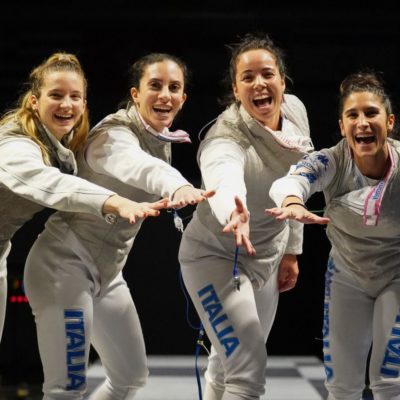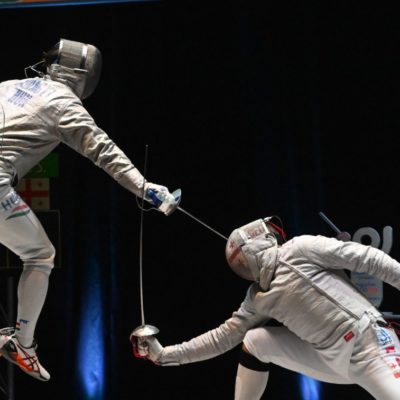Fencing with the new timings!
{mosimage}This DVD from Fencing Pictures features the men’s Individual and Team finals of the 2005 Paris CIP. When you pop this DVD in, there are two simple choices: Individual and Team. The Fencing Pictures DVD menu, though cool as always, is greatly simplified and lets you jump directly to the action.
If you have other Fencing Pictures products, you’ll grin at the sound of Alex Ripa’s voice announcing the fencers and setting the scene. He is becoming as familiar and trustworthy as James Levine announcing for the Metropolitan Opera, a voice that makes you want to settle back and enjoy. Guillermo Alger co-announces, providing volumes of background data on the fencers and even cracking some jokes.
Individual finals: Zhang (China) vs. Le Pechoux (France)
Two lefties take the raised strip before a packed Parisian audience. These are not "standard" final fencers, though Le Pechoux is at least familiar from his 13th place finish at the Olympics. The dominating Italians are nowhere to be seen, and the 2004 Olympic Gold Medalist Brice Guyart got knocked out before the round of 32.
Clearly, something has happened to drastically change — or at least challenge — the natural order of the world-class fencers.
This DVD is tremendously important, because it contains the first distribution of foil fencing under the new timings. Fencers must now keep their tip depressed on the opponent’s target for 15 miliseconds, which is roughly a day measured in foil-tip time. Fencers must also protect their attacks more, because the lockout time is 350 milliseconds and a defender can lock slow attackers out of the action by turning on a light.
| CIP 2005 Final: Zhang CHN – Le Pechoux FRA |
The timing changes, announced in late 2003 and apparently widely disregarded, seemed to catch the elite foilists by surprise. In this tournament, one of the first with the new times, the usual powerhouse fencers were eliminated early.
Fencing was never a very unified sport, but consensus is in a shambles right now, from the office of the FIE President down to the local clubs. If you like the new timings, fencers will tell you you’re not good enough to be hurt by them. If you hate the new timings, you’ll be accused of being too impatient or too inflexible with your technique. The best bet, and FIE President Rene Roch’s apparent strategy, is to (mostly) stay out of the argument until November 2005, which is when the FIE Congress will purportedly "revisit" the timings, and see how improved or degraded foil has become. And meanwhile, clean up your technique.
This DVD has the new foil fencing, and it looks rather like you’d expect. These fencers, born-and-bred on absence-of-blade attacks, are now wary of each other’s counter-attacks. They will need to train up the tiny movements and tight tip-work which (some technique-wonks claim) is what you really need to score. The distance is long, and the actions that work best are long lunges and counters into excessive preparations. Zhang seems most "adjusted" in the early bout, launching a string of attacks that cross the strip and land in low-line target with a flying lunge.
Le Pechoux, for his part, still pulls his hand during his attacks, inviting several capable stop-hits from his opponent. He attempts to escape Zhang’s tip by closing distance, but the director isn’t interested in seeing this become a jab-fest — a yellow card for corps-a-corps soon becomes a red card. Le Pechoux will have to fence this one in distance, keeping Zhang in front of him.
At 6-1 Zhang, Zhang has scored with several beautiful long attacks, some counters (which would have worked even under the old timings), and a dominating parry riposte. Even if he isn’t a regular top-16 fencer, you can see how he could be one. He is very strong, with compact actions and an interesting running invitation, but he is getting tired by the second period (both of these fencers fenced the full tournament, neither had byes out of pools). Le Pechoux has an unshakeable grip on his competitive psychology, and fights with impressive determination even during the very uneven first period.
Le Pechoux begins asserting in the second period. He finds his long attack, makes direct beat attacks, and uses his preparations to invite a commitment from Zhang which he can then parry. Meanwhile Zhang seems to wane, substituting his long lunges with fleches, and waiting to use his parry riposte. When both fencers are out of energy, they double-out, which usually goes to Zhang for his springy lunge, or they charge forward onto the opponent’s tip with pulled-hand attacks.
Both fencers know what is working — long attacks, and very coherent bladework. They know what they need to do, but do they have the energy to do it? Both fencers slow visibly by the end of the period, but enter the third period recharged. It looks exhausting to fence these new timings "right."
Team Final, France vs. Poland
Team France gave a largely unspectacular performance in Individuals, before their home crowd, but they are top-notch today in the team, with a lot to prove. Poland, meanwhile, has been fencing out of its mind, even eliminating Italy to get into the final.
Le Pechoux starts for the French, and has come to some kind of temporary understanding with the timings. He scores with a strong beat attack, and then a bread-and-butter counter when Szuchnicki over-prepares coming forward.
The first bout is an interesting study of the new timings: Le Pechoux will not commit to an absence-of-blade attack against Szuchnicki, who may be a foot taller and certainly has a tremendous reach. Instead, he waits to find a definitive beat before launching his attack. At one point, Le Pechoux beats, but takes too long to bring his tip around to Szuchnicki’s flank — Szuchnicki is immediately ready with a stop-hit. Like his Polish opponent, Le Pechoux also picks the low-hanging fruit, making simple counters into Szuchnicki’s jangly, frequently disconnected preparations. If this footage contains any information about how to fence the timings, it’s be tight and don’t show openings.
France’s next fencer, Attely, fences very tightly, three times making mouse-trap ripostes from a high-septime parry with step-in. He finished 109 (out of 125) in the individuals, which is difficult to believe given his powerful presence on the strip.
In contrast is Guyart. Guyart comes in with a 10-1 lead, but his favorite actions are not conducive to the new timings. He has a tremendous lunge but often couples it with a hand that is pulled back to the hip. He has a tremendous fleche, but it doesn’t surprise Poland’s vastly experienced Mocek. When Guyart pulls his hand, Mocek is ready with a stop-hit. When Guyart parries and takes too long to riposte, Mocek is there with the remise. They finish their period with the score 3-4 Mocek — but 13-5 team.
Team matches are either 44-44 nail-biters, or they’re interesting for a different reason. This match is an example of the latter. While Poland fights hard, anchored by Mocek, France is simply too intense and driven to let their lead be threatened.
Throughout the team match, the effects of the new timings can be seen (and studied). There is a single flick that results in a touch — though a few more are used as a threat. There are straight (not flicked) ripostes, with disengages, that actually matter to the bout — this is something that has been rare in many tournaments in the past years. There are still wide sweeping parries, but if you advertise that you’re going to sweep, the opponent can gain an edge on you with a quick remise. If you make a beat attack, you must go directly to target if the opponent is close. The relaxed, slow marching attacks that cross the strip and result in one light — those are not in evidence at all, though you wouldn’t look to France or Poland for those kinds of attacks.
All of this results in fencers that are sometimes tentative about attacking, and a lot of attacks that simply don’t score. The intensity is the same, but the clock frequently runs out, leaving both teams below the maximum score. It used to be that you could see the score in a team match, and know which bout was being fenced. At 30-22 France, the teams enter their last match; they ought to be going to 45. This level of intensity, for the reduced results, is clearly exhausting to the fencers. They (we) all have some work to do before the new timings feel comfortable.
Conclusion
The production quality of this DVD is the best the fencing world has seen. Slow-motion replays, cool zooming transitions between touches, excellent commentary, tons of information about tactics and technique to be gleaned from both the fencing and the announcers. Also wonderful — during slow-motion replays where the director is off-screen, a cool inset videobox shows the director making his call.
Excellent quality, important fencing. This is a no-brainer.
Reviewed by Walter Flaschka





